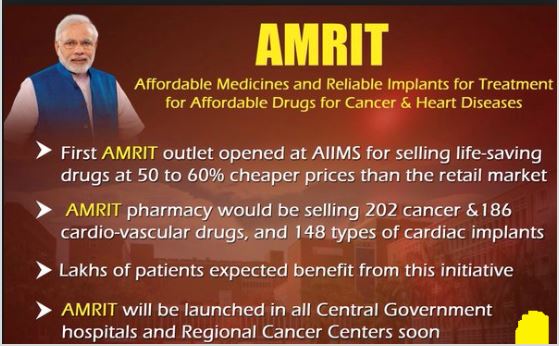(HOT) UPSC Current Affairs 2025 PDF
NEW! The Gist (NOV-2025) | E-BOOKS
AMRIT Scheme : Important Topics for UPSC Exams
AMRIT Scheme : Important Topics for UPSC Exams
What is the AMRIT Scheme all about?
-
It was launched in 2015 by the Health Ministry as an Affordable Medicines and Reliable Implants for Treatment (AMRIT) programme.
-
Under this AMRIT medicine outlet will be opened across India to cater medicines at very low costs.
-
The country’s 1st AMRIT outlet was opened at AIIMS to provide the said medicines at 60-90 % discounts over market prices. Till now 16 such pharmacies have been opened. Moreover the target is 284 such outlets in the next 2 years.
-
It will be launched in all central government hospitals soon.
-
It is being implemented through Mini-Ratna PSU, HLL Lifecar Ltd.
What is its main Objective?
-
The primary aim of AMRIT is to make available and accessible, at very affordable rates, all drugs, implants, surgical disposables that are not dispensed free of cost by the hospitals.
-
These pharmacies stock nearly 2,200 drugs, surgical disposables and implants (including for cardiovascular, cancer and diabetes, stents etc.) that are accessible at an average discount of 63 percent on prevailing market rates.
Why this scheme is very important?
-
Cancer: As per some reports, there are 2.5 million people who suffer from Cancer at any point of time in India out of those 5 lakh die and again 7 lakh new cases are added every year. Thus India has a sizable cancer patient who needs affordable care.
-
Cardiovascular: It is responsible for 25% deaths in 25-69 age group.
-
Breast Cancer: 1,45000 cases are identified annually out of which 50% die due to unaffordable drug problem.
-
In urban India death rate is 32 % and in rural India it is 22.9 % due to the above said diseases.
Conclusion
Drug prices are only one part of the solution and further costs are also involved in treatment of the disease. Physician charges, hospital costs and other costs on medical examinations result in drug charge being a slice of the overall treatment cost.
Moreover, both the diseases are not covered by the most insurance companies, or covered with so many requirements that it is almost impossible to make a medical claim for the treatment. Treatment of these diseases is a big burden for most of the middle class.


